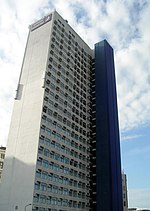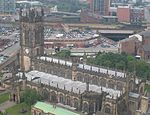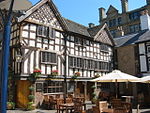Victoria Bridge, Manchester

Victoria Bridge is a stone arch bridge in Greater Manchester, England. Completed in 1839 and named after Queen Victoria, it crosses the River Irwell, connecting Salford to Manchester. The bridge replaced an earlier medieval structure, Salford Old Bridge, which dated from the 14th century. The old bridge was built on the site of an ancient ford, from which Salford took its name. Contemporary accounts of its design are complimentary, but by the 19th century its narrow construction was viewed as an impediment to traffic, and it was demolished. Construction of the new bridge began in 1838 and it was completed about a year later, at a cost of about £20,800. It was opened to traffic on 20 June 1839, although Queen Victoria did not visit it until October 1851. Victoria Bridge is made from sandstone, and uses a single semi-elliptical arch of about 100 feet to cross the water below. It was declared a Grade II listed building in 1988.
Excerpt from the Wikipedia article Victoria Bridge, Manchester (License: CC BY-SA 3.0, Authors, Images).Victoria Bridge, Manchester
Victoria Bridge Street, Salford City Centre
Geographical coordinates (GPS) Address External links Nearby Places Show on map
Geographical coordinates (GPS)
| Latitude | Longitude |
|---|---|
| N 53.484854 ° | E -2.245973 ° |
Address
Victoria Bridge
Victoria Bridge Street
M3 5AS Salford, City Centre
England, United Kingdom
Open on Google Maps











